Having Fun With Epic Fantasy Tropes #9: Artefacts of Power—And Doom—And Where To Find Them
Artefacts of power, and/or doom, are one of the great staples of epic fantasy and the myths, legends, and folklore that inform the literature. Given they’re frequently the object of heroic quests, this instalment of “Having Fun With Epic Fantasy Tropes” is closely linked to Instalment 8, “We’re All Going On A MacGuffin Hunt.”

Starting With Swords…
Those of you who are following this series will also be aware that it has a predecessor in a guest post (one of a mini-series of three) I put together for (the sorely and sadly missed) SF Signal, awa’ back in the mists of time, aka 2011 (gulp!) The post was titled “The Soul-Sucking Sword”, which constitutes an artefact of power if ever there was one (imho.) The specific swords featured in that post are:
.
 Stormbringer from Michael Moorcock’s Elric of Melnibone series
Stormbringer from Michael Moorcock’s Elric of Melnibone series- Gonturan, the Blue Sword, made famous in Robin McKinley’s Damar books
- Changeling, as featured in CJ Cherryh’s Morgaine ‘verse
- Dragnipur, the sword of Anomander Rake in Steven Erikson’s Malazan: The Book of the Fallen
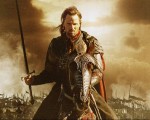
Aragorn & Andúril
Other swords I’ve mentioned around the interweb traps include Narsil, the ‘Sword That Was Broken’ in the backstory to JRR Tolkien’s The Lord Of The Rings, which was then reforged as Andúril, the Flame of the West, for Aragorn.
 And one cannot discuss artefacts or swords of power without reference to Excalibur from the many variants of the King Arthur legend. Not the least of those was Excalibur’s re-imagining as Caliburn, the sword of the fallen (Roman) Emperor Maximus, in Mary Stewart’s wonderful Arthurian sequence.
And one cannot discuss artefacts or swords of power without reference to Excalibur from the many variants of the King Arthur legend. Not the least of those was Excalibur’s re-imagining as Caliburn, the sword of the fallen (Roman) Emperor Maximus, in Mary Stewart’s wonderful Arthurian sequence.

Gandalf the Grey with Glamdring
The reason for the frequent mentions is because swords of power seem to hold pride of place in epic fantasy. In The Lord of the Rings, for example, we also have a significant number of other named swords, including Orcrist, Glamdring, and Sting… I believe this preeminence is understandable in a branch of Fantasy literature that is also known as “Heroic fantasy” and “High fantasy” although heroes may use many weapons, hand to hand combat in the realm of high deeds is most often with a sword. Similarly, although knights might use other weapons historically, such as the battleaxe and mace, the sword was seen as a knightly and even princely weapon, i.e. when being made a knight by someone of higher status, the candidate was—and is—“dubbed” by means of a sword.
 “Hold on,” you may cry, “what about Druss, the legendary axeman in David Gemmell’s groundbreaking heroic fantasy, Legend?” To which I reply—nodding sagely—that although Druss is clearly one of the three leading protagonists in Legend, in the context of the book he is i) not of the high, knightly classes; and ii) does not see himself as heroic, although others clearly do. It is Rek, who becomes the Earl of Bronze, albeit through marriage, who is the great swordsman. Serbitar and the Thirty, who are mostly if not all of noble birth, also primarily use swords.
“Hold on,” you may cry, “what about Druss, the legendary axeman in David Gemmell’s groundbreaking heroic fantasy, Legend?” To which I reply—nodding sagely—that although Druss is clearly one of the three leading protagonists in Legend, in the context of the book he is i) not of the high, knightly classes; and ii) does not see himself as heroic, although others clearly do. It is Rek, who becomes the Earl of Bronze, albeit through marriage, who is the great swordsman. Serbitar and the Thirty, who are mostly if not all of noble birth, also primarily use swords.
As for where one finds such swords, the aspiring sword wielder should look among goblin hordes and in lakes and caves, as well as thrust into stones or already in the possession of great heroes and powerful wizards.
However, since I’ve given swords pride of place in SF Signal and other posts in the past, today I’m going to focus on alternative artefacts of power.
…Then Moving Right Along
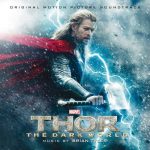
Thor & Mjolnir
Coming back to the mythic origins of epic, I thought we’d look at some of the prototypes for artefacts of power and doom. From the aegis (a shield), winged sandals, and cap of of visibility borrowed by Perseus (from the gods Athena and Hermes respectively) to the arms of Achilles; and from the Golden Fleece to the Holy Grail; the hammer of Thor (Mjolnir) to the Four Treasures of Erin (the sword, spear, stone, and cup/cauldron of the Tuatha Dé Danann); and Aladdin’s lamp to Maui’s fishhook, myth and folklore abounds with them.

Excalibur (the film)
A few of my other favourites include (without being at all exclusive!) Brisingamen, the necklace of the Norse goddess Freya, and Skidbladnir, the magical ship of her brother, Frey. Argo, the vessel of Jason and his fellow heroes, also has an honorable place in artefact history. Excalibur’s scabbard has considerable potency and the bows of Paris, Philoctetes, and Odysseus all get honorable mentions in The Iliad and The Odyssey respectively. Given their ubiquity, it’s little wonder they are firmly entrenched in both fantasy generally and epic fantasy in particular.

A “farmgal” goes on a journey…
Why “in particular”, you may well ask. My personal view is that it’s because artefacts of power and/or doom, or both, go hand in hand with the farmboy or farmgal, prince or princess, who embarks on a quest-journey to save the world and/or find her or his destiny. The artefact may be the MacGuffin, as discussed last time, or an aid to the protagonist in seeking to either find or destroy another artefact.
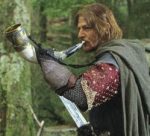
Boromir and the Horn of Gondor
For example, in The Lord of the Rings, Frodo and his eight companions are seeking to destroy the One Ring, but of their company, three have magic swords (Aragorn and Andúril; Gandalf and Glamdring; Frodo and Sting.) In addition, Boromir has the Horn of Gondor and Galadriel makes additional gifts to the company, including the Phial intended to provide light “when all other lights go out.” In the backstory, too, we find objects of power such as the silmaril (a great jewel that is eventually set among the stars) and Aiglos, the spear of Gil-Galad.

Lucy receives her gift of healing cordial
The Lord Of The Rings is by no means alone in this respect. Starting with children’s literature, in The Lion, the Witch and the Wardrobe Father Christmas gives three of the four Pevensey children a sword and shield, a bow and horn, and a dagger and healing cordial respectively. This makes Father Christmas’s sack a good starting point for those who seek similar gifts.
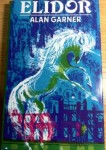 Alan Garner goes directly to the Four Treasures of Celtic myth in Elidor, which are found in a mound. These may also be found, although not necessarily in their official Four Treasures guise, in other Celtic-inpsired fantasy novels, such as Guy Gavriel Kay’s Fionavar series and Susan Cooper’s The Dark Is Rising quintet.
Alan Garner goes directly to the Four Treasures of Celtic myth in Elidor, which are found in a mound. These may also be found, although not necessarily in their official Four Treasures guise, in other Celtic-inpsired fantasy novels, such as Guy Gavriel Kay’s Fionavar series and Susan Cooper’s The Dark Is Rising quintet.
 In Garner’s The Weirdstone of Brisingamen the treasure is a stone and not the necklace of Norse myth, but it’s rightful resting place is also a cave. Returning to Susan Cooper’s The Dark Is Rising series (as mentioned in the MacGuffin post), the five books centre on the finding of longlost artefacts that will support the power of the light and turn back the dark. These include the grail, a codex to decipher it, and the “six signs” of Will Stanton’s Twelfth Night quest in the second book, also titled The Dark is Rising. As for where to find such items, “over sea and under stone” and generally secreted in unexpected places is the order of things.
In Garner’s The Weirdstone of Brisingamen the treasure is a stone and not the necklace of Norse myth, but it’s rightful resting place is also a cave. Returning to Susan Cooper’s The Dark Is Rising series (as mentioned in the MacGuffin post), the five books centre on the finding of longlost artefacts that will support the power of the light and turn back the dark. These include the grail, a codex to decipher it, and the “six signs” of Will Stanton’s Twelfth Night quest in the second book, also titled The Dark is Rising. As for where to find such items, “over sea and under stone” and generally secreted in unexpected places is the order of things.
 In Philip Pullman’s Golden Compass trilogy, the first book is centered around the mysterious alethiometer, a truth-telling and predictive compass that only Lyra can readily interpret. In the second book, The Subtle Knife, the blade for which the book is named opens gateways between parallel universes. The armour of the panzerbjorn is also a significant artefact as well as the essence of the bears’ physical and spiritual being. The latter are only found in the forges of the frozen north.
In Philip Pullman’s Golden Compass trilogy, the first book is centered around the mysterious alethiometer, a truth-telling and predictive compass that only Lyra can readily interpret. In the second book, The Subtle Knife, the blade for which the book is named opens gateways between parallel universes. The armour of the panzerbjorn is also a significant artefact as well as the essence of the bears’ physical and spiritual being. The latter are only found in the forges of the frozen north.
 As for JK Rowling’s Harry Potter, in which the books grow increasingly epic as the story progresses, the series features an abundance of artefacts of power. These include the philosopher’s stone of the first book (try Gringott’s vaults and/or caves beneath Hogwarts), the cloak of invisibility, the sword of Gryffindor (the Sorting Hat provides sure access), Hermione’s timeturner (professors such as Minerva McGonagall are a reliable source), and the goblet of fire (enchanted within a maze) for which the fourth book is named—not to mention the seven horcruxes in which Lord Voldemort has secreted part of his being. The latter will always be concealed in secret and highly dangerous locations.
As for JK Rowling’s Harry Potter, in which the books grow increasingly epic as the story progresses, the series features an abundance of artefacts of power. These include the philosopher’s stone of the first book (try Gringott’s vaults and/or caves beneath Hogwarts), the cloak of invisibility, the sword of Gryffindor (the Sorting Hat provides sure access), Hermione’s timeturner (professors such as Minerva McGonagall are a reliable source), and the goblet of fire (enchanted within a maze) for which the fourth book is named—not to mention the seven horcruxes in which Lord Voldemort has secreted part of his being. The latter will always be concealed in secret and highly dangerous locations.
 If we look back to ships such as the Argo and Skidbladnir—not to mention Prydwen, the ship that bore Arthur to the Celtic underworld—magical vehicles such as the enchanted Ford Anglia in The Chamber Of Secrets and the Knight Bus in The Prisoner Of Azkaban also count as artefacts of power. And when it comes to ships (although it’s not epic fantasy) I do have to mention Hilda Lewis’s children’s classic, The Ship That Flew, in which the ship turns out to be Skidbladnir. As for where it’s found, try a secondhand shop with a mysterious proprietor…
If we look back to ships such as the Argo and Skidbladnir—not to mention Prydwen, the ship that bore Arthur to the Celtic underworld—magical vehicles such as the enchanted Ford Anglia in The Chamber Of Secrets and the Knight Bus in The Prisoner Of Azkaban also count as artefacts of power. And when it comes to ships (although it’s not epic fantasy) I do have to mention Hilda Lewis’s children’s classic, The Ship That Flew, in which the ship turns out to be Skidbladnir. As for where it’s found, try a secondhand shop with a mysterious proprietor…
 In terms of artefacts that bridge Children’s and Adult literature, one can say that this is “all of them!” since artefacts of power are integral to epic fantasy. Ships, though, are one of my particular favourites, possibly because I always wanted to be an Argonaut as a kid. 😉 So it may then come as no surprise to learn that Robin Hobb’s Liveship Traders trilogy, which starts with Ship of Magic, is a favourite of mine and that I heart all the ships. Vivacia and Paragon are definitely just as much characters as the human protagonists. (At this point, of course, I yearn to mention Iain M Banks’s Culture ships, but of course I can’t because, fantastic though they are, they’re definitely Science Fiction and not Fantasy.)
In terms of artefacts that bridge Children’s and Adult literature, one can say that this is “all of them!” since artefacts of power are integral to epic fantasy. Ships, though, are one of my particular favourites, possibly because I always wanted to be an Argonaut as a kid. 😉 So it may then come as no surprise to learn that Robin Hobb’s Liveship Traders trilogy, which starts with Ship of Magic, is a favourite of mine and that I heart all the ships. Vivacia and Paragon are definitely just as much characters as the human protagonists. (At this point, of course, I yearn to mention Iain M Banks’s Culture ships, but of course I can’t because, fantastic though they are, they’re definitely Science Fiction and not Fantasy.)
 Musical instruments are another of my favourite artefacts of power. I’ve always had a particular fondness for the cwidder (a musical instrument, reminiscent of a lute) that Moril uses to bring down mountains in Diana Wynne Jones’ Cart and Cwidder. In literature for older readers, I’ve always respected Morgon of Hed’s starred harp (in Patricia McKillip’s Riddlemaster trilogy), which has a lowest string that will snap steel and shatter stone. Unlike the cwidder, though, which belonged to Moril’s father before he inherited it, Morgon’s harp is a “found” object.
Musical instruments are another of my favourite artefacts of power. I’ve always had a particular fondness for the cwidder (a musical instrument, reminiscent of a lute) that Moril uses to bring down mountains in Diana Wynne Jones’ Cart and Cwidder. In literature for older readers, I’ve always respected Morgon of Hed’s starred harp (in Patricia McKillip’s Riddlemaster trilogy), which has a lowest string that will snap steel and shatter stone. Unlike the cwidder, though, which belonged to Moril’s father before he inherited it, Morgon’s harp is a “found” object.
 When it comes to artefacts of doom, stones hold a distinguished place in the literature. The stone called the Terrenon, in Ursula Le Guin’s A Wizard Of Earthsea, and the Stone-at the-Heart-of-the-Deep in Barbara Hambly’s Dragonsbane, are both sources of great power that can be drawn on by others. The difference is that in Earthsea, the Terrenon is clearly evil, whereas the Dragonsbane Stone is neutral but the will of the user determines whether the magic is turned to good or evil ends. Both stones are to be found in secret chambers, deep within the earth.
When it comes to artefacts of doom, stones hold a distinguished place in the literature. The stone called the Terrenon, in Ursula Le Guin’s A Wizard Of Earthsea, and the Stone-at the-Heart-of-the-Deep in Barbara Hambly’s Dragonsbane, are both sources of great power that can be drawn on by others. The difference is that in Earthsea, the Terrenon is clearly evil, whereas the Dragonsbane Stone is neutral but the will of the user determines whether the magic is turned to good or evil ends. Both stones are to be found in secret chambers, deep within the earth.
 Golden torcs are a crucial artefact in Julian May’s Saga of the Exiles quartet, as it is the torcs that enable the Tanu (i.e. the sidhe or fey) and those humans allied with them, to access their psychic and magical powers. Being born to or enlisting in the ranks of the Tanu is the usual way to obtain one. Golden torcs also play a significant part, for weal and woe, in Diana Wynne Jones’ Power of Three.
Golden torcs are a crucial artefact in Julian May’s Saga of the Exiles quartet, as it is the torcs that enable the Tanu (i.e. the sidhe or fey) and those humans allied with them, to access their psychic and magical powers. Being born to or enlisting in the ranks of the Tanu is the usual way to obtain one. Golden torcs also play a significant part, for weal and woe, in Diana Wynne Jones’ Power of Three.
 In David Gemmell’s Legend (mentioned above), Druss’s axe Snaga may be named but it has no magical powers. The armour of the Earl of Bronze, however—which also appears in Waylander, the prequel to Legend—is known as “the soul of the Earl of Bronze” and has considerable legendary and mystical status in the hearts and imaginations of the populace. As to where to find it, it is in “a deep cave high up the side of a tall mountain” in Waylander, and in a locked room beneath the fortress of Dros Delnoch in Legend—where the Earl’s sword is encased in a block of mysterious crystal.
In David Gemmell’s Legend (mentioned above), Druss’s axe Snaga may be named but it has no magical powers. The armour of the Earl of Bronze, however—which also appears in Waylander, the prequel to Legend—is known as “the soul of the Earl of Bronze” and has considerable legendary and mystical status in the hearts and imaginations of the populace. As to where to find it, it is in “a deep cave high up the side of a tall mountain” in Waylander, and in a locked room beneath the fortress of Dros Delnoch in Legend—where the Earl’s sword is encased in a block of mysterious crystal.
 No discussion of artefacts of power would be complete without reference to The Luggage from Terry Pratchett’s Discworld series. The Luggage is first encountered following the tourist, Twoflower, who hails from the Counterweight continent and gifts The Luggage to the wizard, Rincewind. The Luggage is distinguished by being able to follow Twoflower or Rincewind anywhere, including into alternate dimensions. It also devours thieves and is the only entity in the Discworld that presents a real challenge to the invincible Coen the Barbarian. If you want your own set of similar luggage, I’m guessing the Counterweight continent is the place to look…
No discussion of artefacts of power would be complete without reference to The Luggage from Terry Pratchett’s Discworld series. The Luggage is first encountered following the tourist, Twoflower, who hails from the Counterweight continent and gifts The Luggage to the wizard, Rincewind. The Luggage is distinguished by being able to follow Twoflower or Rincewind anywhere, including into alternate dimensions. It also devours thieves and is the only entity in the Discworld that presents a real challenge to the invincible Coen the Barbarian. If you want your own set of similar luggage, I’m guessing the Counterweight continent is the place to look…
So Why Are Artefacts So Important In Fantasy Storytelling?
 Fantasy in general and epic fantasy in particular is often categorized as intrinsically nostalgic and inherently anti-tech. Yet I find it fascinating that artefacts are integral to fantasy storytelling, since they are created or shaped objects and in this sense technological, although usually from an earlier age. The stolen computer in Barbara Hambly’s The Silent Tower is one exception to that rule, though.
Fantasy in general and epic fantasy in particular is often categorized as intrinsically nostalgic and inherently anti-tech. Yet I find it fascinating that artefacts are integral to fantasy storytelling, since they are created or shaped objects and in this sense technological, although usually from an earlier age. The stolen computer in Barbara Hambly’s The Silent Tower is one exception to that rule, though.
In considering their central place in myth, legend and literature, I have come up with two potential explanations.
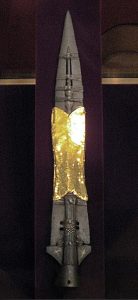
The Holy Lance of Antioch, displayed in the Imperial Treasury, Hofburg Palace, Vienna
The first is that tools, weapons, and other artefacts have been and still are essential to humanity’s physical and cultural survival and success. As such, they will also, inevitably, provide outward evidence of wealth and social prominence. So it’s not surprising that the importance of ships and cauldrons, musical instruments and jewellery, swords and armor, are reflected in human stories.
Another reason their allure has proven so enduring, even as societies and stories change, is because created objects—especially valued and powerful ones—do endure, well beyond the generation that created them. So they and their magic may be handed down, transcending generations. You’ll recall, too, that the sweep of time is one of the distinguishing characteristics of epic fantasy and a sword, cwidder, or ring can bridge generations and millenia—exactly as archaeological finds do in our everyday, “muggle” world. 🙂
Note: The attribution for the lance image is as follows: "By Weltliche_Schatzkammer_Wien_(180)-3.jpg: *Weltliche_Schatzkammer_ Wien_(180).JPG: Gryffindorderivative work: Saibo (Δ) - Weltliche_Schatzkammer_Wien_(180)-3.jpg, CC BY-SA 3.0, https://commons.wikimedia.org/w/index.php?curid=11725211"
So, Wot About My Writing , Then?
 An excellent question. As a reader, listener, and viewer, I have always loved artefacts of power in all their forms so it’s no surprise one or even quite a few of them appear in Thornspell and The Wall Of Night series.
An excellent question. As a reader, listener, and viewer, I have always loved artefacts of power in all their forms so it’s no surprise one or even quite a few of them appear in Thornspell and The Wall Of Night series.
In Thornspell, the primary artefact of power (AoP) is Quickthorn, the red-and-white sword that “the dragons made for Parsifal” —provenance being important to AoPs 🙂 — and which is found in, yes indeed, a cave tomb…Conversely, the foremost artefact of doom (AoD) is the blue ring worn by the chief antagonist, the Margravine zu Malvolin.

USA
As discussed in the preceding post on MacGuffins, the arms of the long-dead hero, Yorindesarinen, play an important part in The Wall Of Night story. In addition to Nhenir, the Moonbright Helm, the Frostfire Sword, and the Shield of Stars, the arms include a magical armband, although this is not named. However, these are not the series’ only artefacts of power.

UK/AU/NZ
At the same time as the main character, Malian, receives the armband, her friend Kalan (the secondary lead) is given a black-pearl ring (the Token) that turns out to be linked to a series of weapons known as Black Blades, which comprise both spears and a pair of swords. The latter weapons are dual-natured in that their power also holds aspects of doom. So, too, does the Web of Mayanne, a tapestry that binds the chaotic Hunt of Mayanne, to which the Token is also directly connected.

Yep, that’s a sword on the cover!
The WALL story’s roll-call of artefacts also includes a bronze mirror (AoD), a walking stick with inset eyes (AoP), and ships that also have eyes depicted on their prows and can speak mind-to-mind (AoP.) There is also a twelve-sided table in the heart of the Old Keep of Winds, as well as rune scrolls, a medallion, and a wand used by one of the secondary antagonists.

UK/AU/NZ
That probably sounds like a lot of artefacts, but the WALL series is a big story and I believe it can accommodate them; I hope readers agree! As for where the WALL artefacts may be found, not infrequently this is outside of time or within the realm of dreams, including in hidden towers (Nhenir), caverns (the Frostfire Sword), tombs (one of the Black Spears) and concealed rooms (the twelve-sided table.)

USA
WALL series artefacts may also be found in more mundane but overlooked locations, such as infrequently used or everyday rooms (e.g. the Web of Mayanne and the bronze shield), or even in a tinker’s cart (the black swords.)

UK/AU/NZ
Almost always, too, they are not where the seeker expects to find them—which is all part of the fun, since it means that anything at all can turn out to be important and every footsoldier, to paraphrase Napoleon, may have a marshall’s baton in his or her knapsack.
—
Next Time: Next up will be Instalment 10: “The Alchemy Of Numbers”—probably on Monday 27 August, but failing that, on 3 September.
—
Previously In This Series:
Introduction: Having Fun With Epic Fantasy—Meet the Tropes
Instalment 1: Having Fun With Epic Fantasy Tropes: A Farm Boy/Gal Goes On A Journey…
Instalment 2: A Prince/Princess Finds A Destiny
Instalment 3: Dreams and Portents, Prophecy and Destiny
Instalment 4: “Apocalypse Now”
Instalment 5: Meet The Big Bad
Instalment 6: The Sweep Of Time & Its Twin, War Without End
Instalment 7: Fortunately There was A Portal
Instalment 8: We’re All Going On A MacGuffin Hunt
—
On SF Signal: The “Having Fun With Epic Fantasy” Series
1. “Making the Grand Tour” (aka the Road Journey);
2. “The “Band of Brothers”; and the
3. “Soul-Sucking Sword.”
---
© Helen Lowe


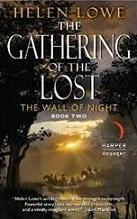
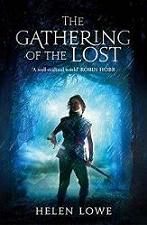
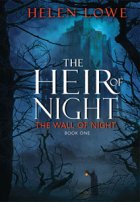
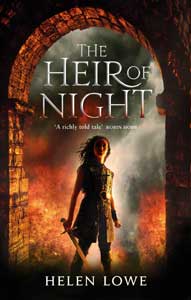


The sword of the Rivan King from the Belgariad was also ‘big’ as swords go, size wise and its importance in the story. But perhaps you didn’t mention it because the sword on its own, without the orb was not functional. The orb itself would be an artifact of power, wouldn’t it? In fact one of the most interesting artifacts of power,one could consider, might be the fallen star from Neil Gaimen’s Stardust. Not to mention the arms of Yorindasarinen, which have kept us intrigued through three books so far. And we get the feeling there is something yet to be revealed about the arm ring.
I agree that the orb is definitely an artefact of power and also feel that the orb and sword together qualify as an artefact, too. I have “me doots” about the star in Stardust, though, because Yvaine, being both a star and a person/personality, cannot be an “artefact”, since that is a “a functional or decorative human-made object.” I agree 100%, though, that she is a wonderful fantasy and literary creation!
Naturally, I must refuse to either confirm or deny about the armring… 😉 I’m really glad you’ve found the arms of Yorindesarinen intriguing, tho’. #MyWorkHereIsDone — #OKMaybeNotQuiteDone #WALL4StillOutstanding 😀